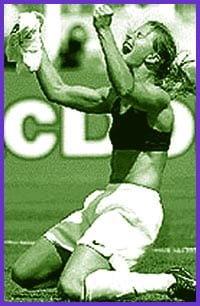The imminent dawn of the 21st century should have made us awed and humble, providing an opportunity to reflect upon the mysteries of human existence.
We should be considering the great art and literature that’s defined the last decade, century and millennium; contemplating the great leaders of history, the biggest disasters of the last thousand years, the world’s most inspiring heroes of all time; celebrating revolutionary inventions like the printing press, the steam engine and antibiotics.
Yet, try as opinion makers might to provide some gravity to the turning of the millennium, it just doesn’t work. Somehow, the two-hour A&E documentary Millennial Lives: Erasmus And Martin Luther, The Original Reform School Boys just isn’t as compelling as, say, Barbara Walters on the Most Fascinating Celebrity Hairstyles Of The Century.
Let’s face it, humans are a crass and middle-brow species, more defined by pop culture than high culture. When Y2K wreaks havoc this week, people will be scrambling for their cell phones, their porn stash and their Libby’s canned beans, not throwing their bodies across first editions of Ulysses or racing to put out the flames engulfing the National Gallery.
And if, like the ancient Pompeiians, urban North American civilization gets buried under rubble and lava, leaving our day-to-day junk perfectly preserved, here are some of the objects, trends and phenomena that will help future anthropologists piece together life in the 1990s….
Vanity Fair. Thick, glossy, obsessed by celebrity in all its forms – from Hollywood stars to obscure European royalty – VF is the magazine of the late 20th century. Optimistic (or, perhaps, pessimistic) editors already have the January 2000 issue on the stands, with a cover featuring a bedouin-ish Carmen Diaz and the delicious, proto-Vanity Fair cover line “The Most Scandalous Rockefeller Divorce Ever.”
Condoms.
The Internet. Mama always said: Never trust anything developed by military intelligence for covert communications. Still, the impact of the Internet and the World Wide Web on modern life cannot be underestimated. Where would we be without on-line shopping, the Slave For Socks Home Page, and the Sympatico high speed dissemination of the “You Know You Grew Up In The 1980s If…” quiz?
Confessional women. Authors Elizabeth Wurtzel, Kathryn Harrison and Joyce Maynard; musicians Alanis Morrisette, Tori Amos.
Country music for people who don’t like country.
Designer drugs.
Elton John tribute performances. More ghoulish than a goth, tragic death attracts the creator of “Candle In the Wind” like nothing else. The 1990s saw him sing at no less than three funerals or memorial services: for Princess Diana, Gianni Versace and Matthew Shepard.
Dueling divas. Whitney vs Mariah. Barbra vs Celine. Rosie O’Donnell vs Tom Selleck.
Killer teens.
Remarkable body parts. Monica Lewinsky’s mouth. Pamela Anderson Lee’s implants. Jennifer Lopez’s booty.
Ghetto fabulousness à la Mary J Blige.
Digital video.
Celebrity lesbian couples. Anne and Ellen. Melissa and Julie. KD and Leisha. Matt and Ben.
White rappers like Eminem saying they know what it’s like to be black because they grew up in the projects. Black singers like Puff Daddy buying summer homes in the Hamptons and partying with Martha Stewart.
The on-going evolution of Cher.
AIDS kitsch. The quilt, red ribbons, Red Hot & Something compilations.
Straight white men: Tom Green. Bill Gates. David Spade. Michael Coren. The guys from The Men Show. Adam Sandler. The statistically typical serial killer. Rob Schneider. Enough said.
Gap Khakis commercials.
Television actresses with anorexia. Oops, I mean, high metabolisms.
Openly gay conservatives.
Grating catch-phrases: “Thinking outside the box,” anything that’s “so not” something, “all that and a bag of chips,” “talk to the hand,” “I’m so over it,” “show me the money,” “getting jiggy with it,” “don’t go there,” “I’m king of the world,” and “groovy, baby.”
Schadenfreude.
Oprah’s book club.
Techno-geek billionaires. And the analogy that Internet entrepreneurs are “virtual prospectors” on a “high-tech gold rush.”
Actors Warren Beatty and Will Smith divulging their desire to become president of the United States.
Television shows created by David E Kelley.
Bioré pore-cleansing strips.
Duet albums by aging or digitally-brought-back-from-the-dead music legends: Frank Sinatra, Tony Bennett, Bob Marley, Burt Bacharach.
Brandy Chastian’s sports bra and the impact of the US Title IX Legislation from the 1970s – which established gender equity in funding for federal programs like school athletics – on amateur and professional women’s sports like basketball, hockey and soccer.
Court TV.
Post-feminist and anti-feminist feminists.
Starbonics. The language created by the Seattle-based Starbucks chain, forcing caffeine-deprived patrons to ask “baristas” for “short,” “tall,” or “grande” coffees.
Indie films.
Video games for adults.
Regis Philben as the saviour of the television game show.
Sex advice columnists.
Natural remedies. Ginko biloba, echinacea, gotu kola, high colonics.
Being “really stressed out.”
Robin Williams in any of a score of roles that, yet again, requires him to laugh through tears.


 Why you can trust Xtra
Why you can trust Xtra


